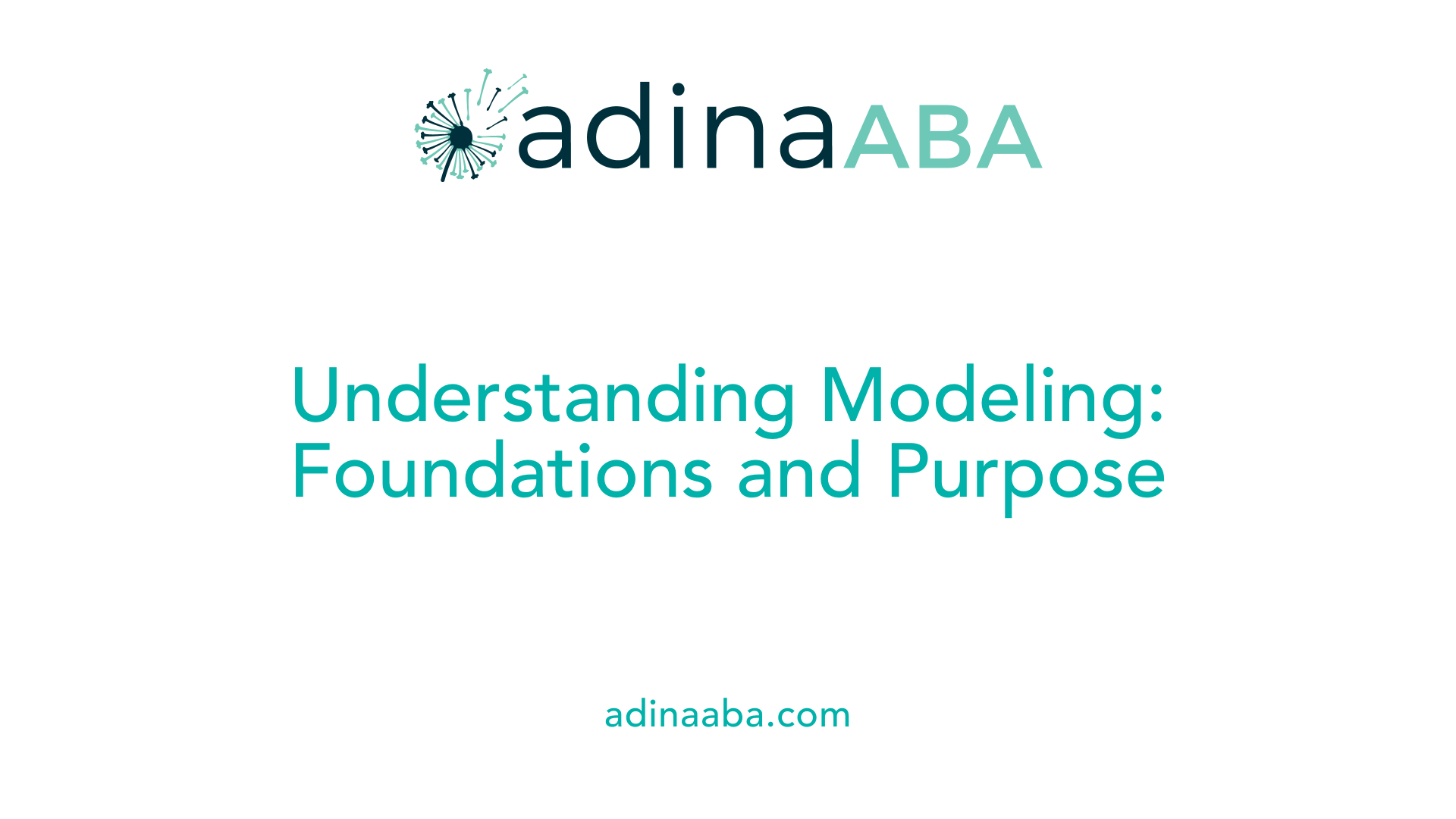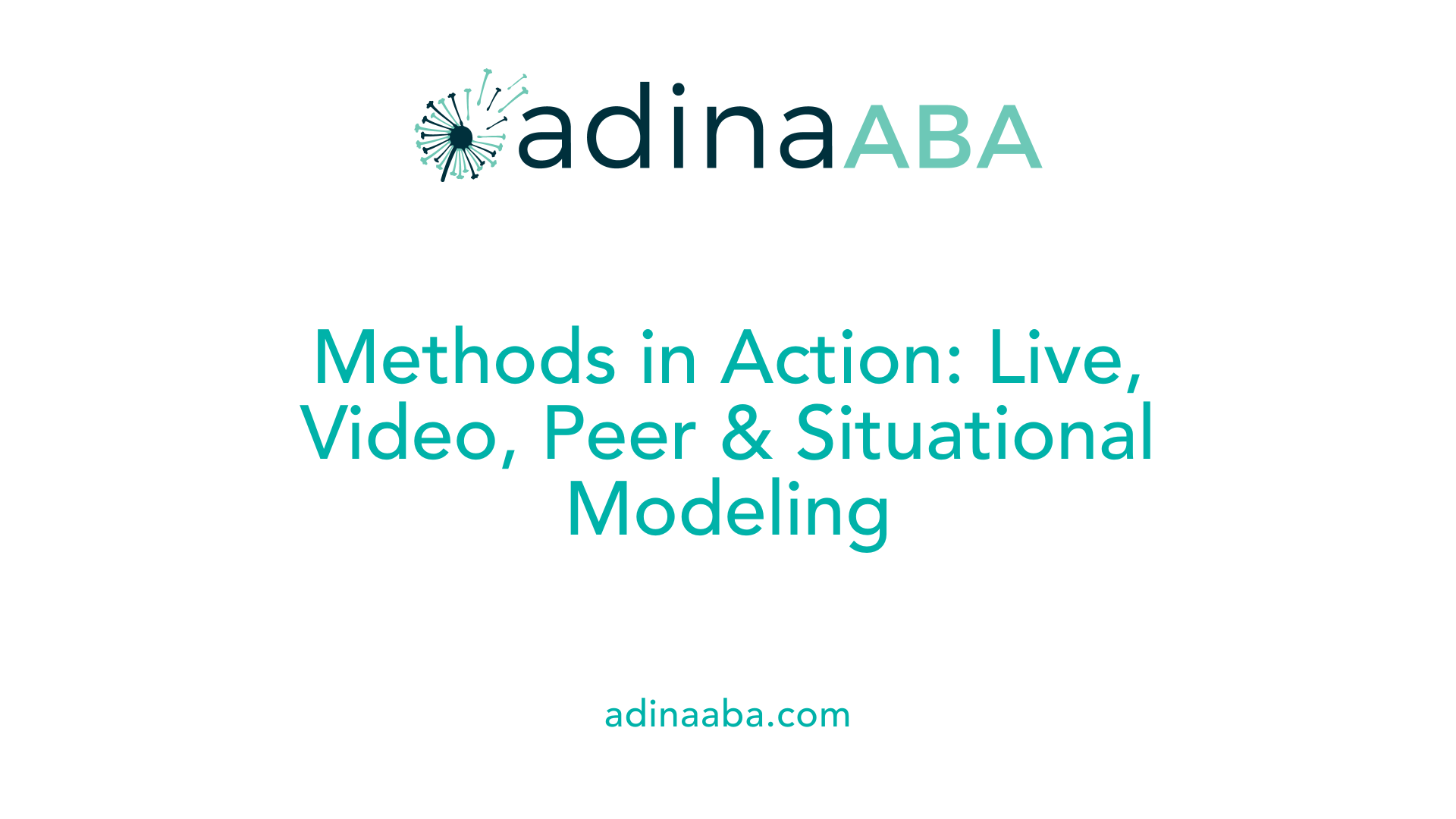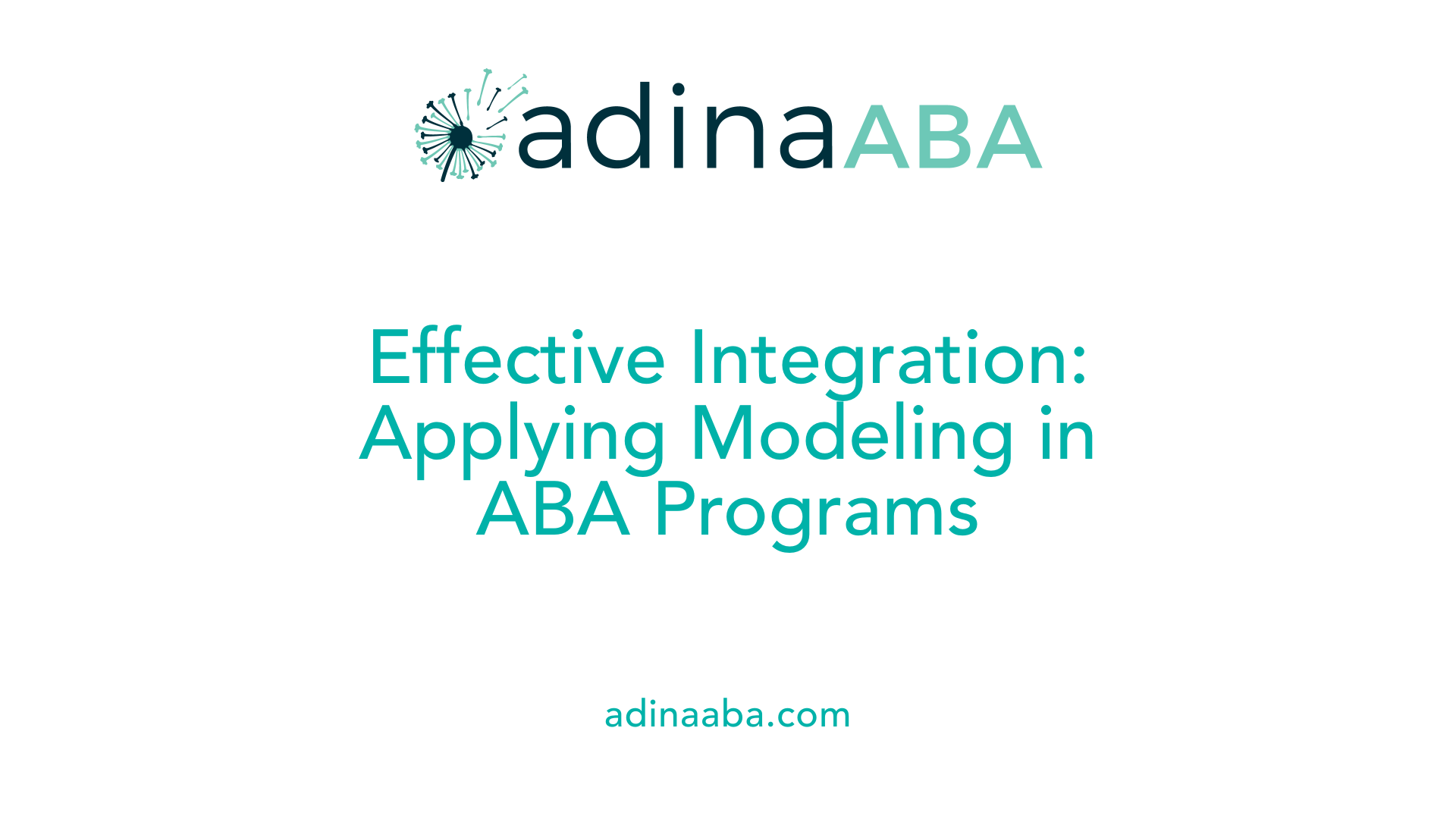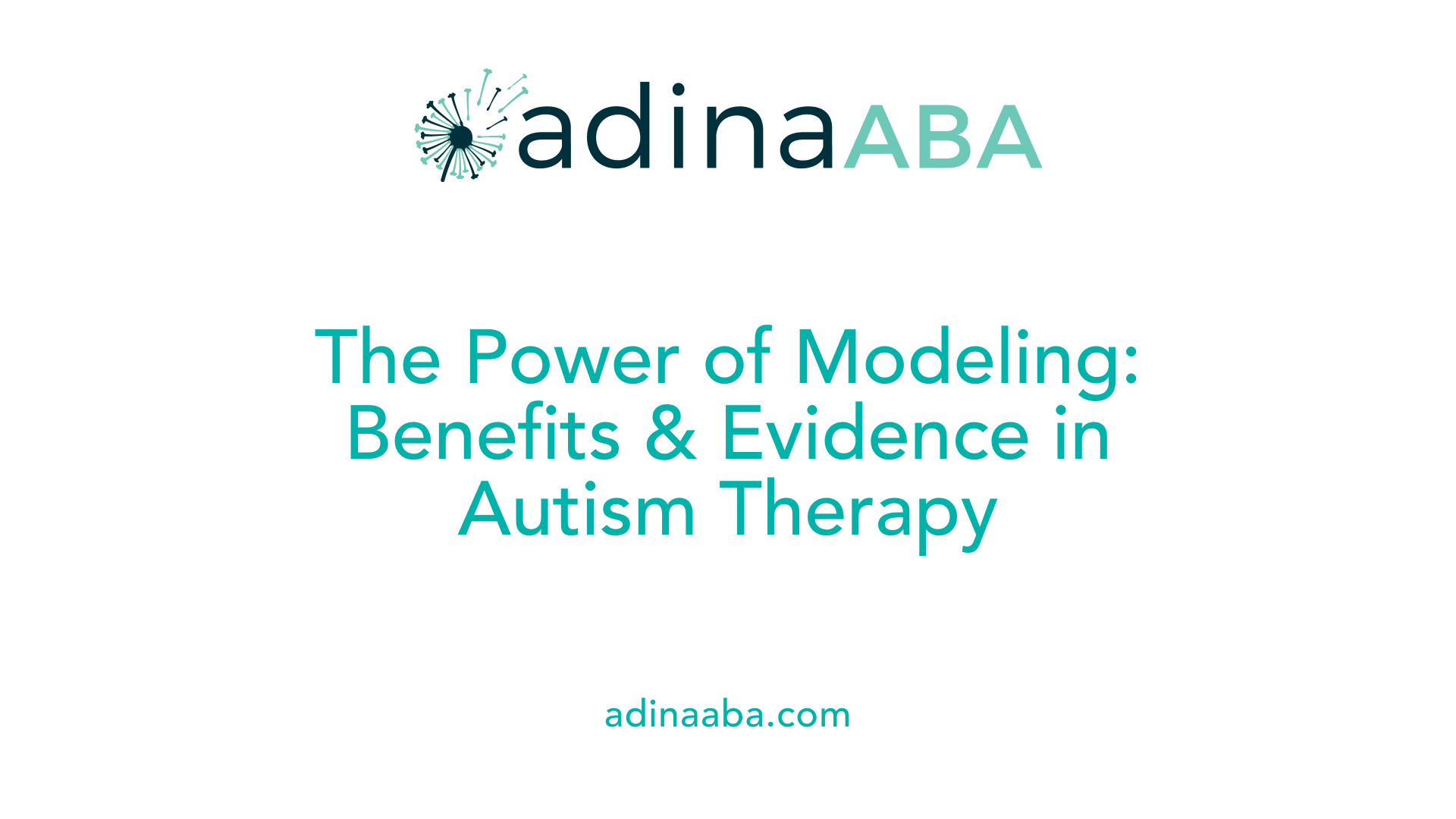The role of modeling in ABA interventions

Understanding the Core Technique of Modeling in ABA
Modeling is a fundamental technique within Applied Behavior Analysis (ABA) that plays a vital role in teaching and reinforcing desired behaviors. It leverages visual, auditory, and kinesthetic demonstrations to facilitate observational learning, which is particularly effective for individuals with autism. By showcasing appropriate behaviors through various forms of modeling, therapists and caregivers enable learners to imitate and adopt new skills with clarity and confidence.
What is Modeling in Behavioral Therapy?

What is modeling in behavioral therapy?
Modeling in behavioral therapy involves demonstrating behaviors for an individual to observe and imitate. This process allows learners to acquire new skills or modify existing behaviors through observation. Typically, models can be in the form of in-person demonstrations, videos, or recordings, showing desired actions in a clear and structured manner.
This technique is rooted in the social learning theory by Albert Bandura, emphasizing learning through observation, imitation, and reinforcement. When a therapist or peer models a behavior, the individual observes the demonstration and then practices imitating it. Consistent practice and reinforcement help solidify the new skills.
How does modeling relate to social learning theory?
Social learning theory explains that people learn behaviors by watching others, especially when the observed actions are reinforced or rewarded. Modeling aligns perfectly with this idea: providing examples of appropriate behavior helps learners understand what to do and motivates them to imitate similar actions.
In ABA therapy, modeling creates opportunities for individuals, especially those with autism, to see clear, concrete examples of social interactions, daily routines, or communication methods. This visual and observable approach simplifies learning, making behaviors easier to understand and replicate.
What are the main purposes and elements of modeling?
The primary goal of modeling is to teach and reinforce new skills while promoting generalization across settings. It's effective for teaching social skills, language, daily routines, and reducing problematic behaviors.
Key components include:
- Demonstration of target behaviors by an in-vivo person, video, or audio
- Observation by the learner
- Imitation prompted and reinforced
- Practice in different environments
In practice, strategies such as live modeling, video modeling, peer modeling, and self-modeling are used. Tailoring the models to the individual’s needs and learning style enhances effectiveness. Consistency in implementation and ongoing support are essential to overcoming challenges like individual variability and maintaining motivation.
By incorporating modeling systematically into ABA programs, therapists can effectively teach complex skills in a clear, observable, and engaging manner, ultimately encouraging independence and success in everyday life.
Techniques and Methods Used for Modeling Within ABA

What techniques are used for modeling within ABA therapy?
Modeling plays a crucial role in ABA therapy, helping individuals, especially those with autism, learn new skills through observation and imitation. Several methods of modeling are commonly used, each tailored to the learner's needs and the specific skills being targeted.
Live modeling involves demonstrating behaviors in real time by a therapist or peer. For example, a therapist might show a child how to greet someone properly, and the child observes and copies the behavior.
Video modeling records demonstrations of desired behaviors, such as brushing teeth or sharing toys, which are then played back for the learner. Research suggests video modeling can lead to faster skill acquisition compared to live demonstrations, particularly for visual learners.
Peer modeling leverages the influence of peers to promote learning. A child might observe a peer successfully requesting an item or playing cooperatively, encouraging similar behaviors.
Situational modeling prepares learners for real-world interactions by demonstrating appropriate responses in specific contexts, like saying ‘Excuse me’ after bumping into someone.
Across all these methods, breaking down complex behaviors into manageable steps and using clear visual or auditory cues are fundamental. Reinforcement following correct imitation reinforces the learned behavior, encouraging repetition and mastery.
In addition to demonstration, modeling techniques are often combined with prompts, scripts, and activity schedules to foster generalization and independence. Proper training and tailoring of these methods are essential to ensure success in applying modeling within ABA sessions.
How are behaviors broken into steps, reinforced, and supported with visual aids?
Breaking behaviors into small, manageable steps simplifies learning and helps prevent overwhelm. For example, teaching handwashing involves steps like turning on the tap, applying soap, rubbing hands, rinsing, and drying.
Reinforcement is used to strengthen each successful imitation, whether through praise, tokens, or preferred activities. Continuous reinforcement during initial learning phases ensures the behavior is well-established.
Visual aids such as pictures, videos, social stories, and written instructions support learners by providing clear, concrete examples of the behaviors being taught. Visual supports are especially effective for individuals with autism, as they enhance understanding and retention.
Together, these techniques promote effective learning, skill transfer across settings, and increased independence, all while accommodating individual learning styles and needs.
Application and Integration of Modeling in ABA Strategies

How is modeling applied and integrated into ABA intervention strategies?
Modeling plays a central role in ABA therapy by providing clear demonstrations of desired behaviors that individuals can observe and imitate. Therapists often use various forms of modeling, such as live demonstrations, video recordings, and peer interactions, to teach social and communication skills effectively. For example, a therapist might physically demonstrate a social greeting or use videos to show someone completing daily routines, enabling learners to see exactly how behaviors should look.
Incorporating reinforcement and prompting techniques alongside modeling enhances learning outcomes. When a learner successfully imitates a behavior, they are typically reinforced with praise or tangible rewards, which encourages repetition and mastery. Prompting facilitates the imitation process, with strategies like verbal cues or physical guidance gradually fading as the learner becomes more independent. This structured approach not only helps in skill acquisition but also supports the generalization of skills across different settings, such as home, school, and community.
Efficient ABA interventions also integrate visual aids—like pictures, charts, and social stories—to complement modeling. These visual tools serve as additional cues, making it easier for individuals, especially those with autism, to understand and remember behaviors.
Advancements in technology have greatly enhanced the application of modeling. Video modeling, in particular, allows learners to repeatedly observe behaviors at their own pace, often resulting in faster acquisition of skills compared to in-vivo methods. Some programs utilize AI and data analysis tools to monitor progress, identify behavioral patterns, and tailor interventions in real-time.
Personalized treatment plans are another vital aspect of effective implementation. By assessing each individual’s needs, strengths, and learning style, therapists can select the most appropriate modeling techniques—whether visual, verbal, or physical—and embed them within daily routines or naturalistic settings. This customization ensures that modeling strategies are both engaging and effective.
How does visual demonstration, reinforcement, prompting, and generalization work together?
Visual demonstration forms the backbone of modeling, offering tangible, observable examples for learners to imitate. Reinforcement follows each successful behavior, motivating continued imitation and mastery.
Prompting serves as a bridge, guiding learners when they are initially unable to perform behaviors independently. Over time, prompts are systematically faded to foster independence.
Generalization is the ultimate goal, where learned skills transfer across different contexts and environments. Continuous practice with varied models and settings ensures that individuals can apply skills in real-life situations.
Use of visual aids, technology, and personalized plans
In practice, these strategies are complemented by a range of visual aids like picture schedules, videos, and social stories, making learning more accessible.
Technological tools, including apps and AI systems, enable real-time data collection, progress tracking, and adjustments to intervention plans. These innovations help ensure that modeling remains responsive to individual progress.
Lastly, crafting personalized plans that reflect each learner’s unique profile maximizes engagement and effectiveness. Such tailored approaches often involve combining multiple modeling methods with other ABA techniques to create a comprehensive, adaptable learning framework.
| Component | Description | Examples |
|---|---|---|
| Visual Demonstration | Real or recorded visuals showing behaviors for imitation | Videos, social stories, picture charts |
| Reinforcement | Rewards or praise following successful imitation | Verbal praise, tokens, preferred activities |
| Prompting | Guidance provided to facilitate imitation | Verbal cues, physical guidance |
| Generalization | Applying skills across multiple settings and situations | Different locations, different people |
| Use of Visual Aids | Supporting materials like pictures, charts, social stories | Visual schedules, flashcards |
| Technology | Digital tools for demonstration, data collection, and feedback | Apps, AI monitoring systems |
| Personalized Plans | Tailored strategies based on individual needs | Custom intervention routines |
By integrating visual demonstration, reinforcement, prompting, and technology within personalized plans, ABA therapy continues to evolve as an effective approach to develop essential skills in individuals with autism and other developmental disorders.
Benefits and Effectiveness of Modeling in ABA for Autism

What are the benefits and effectiveness of modeling in ABA therapy for autism?
Modeling in ABA therapy is a powerful and widely used teaching method that helps individuals with autism learn new behaviors or skills through observation and imitation. This technique involves demonstrating a desired behavior in various ways, such as live demonstration by a therapist or peer, through videos, or via audio recordings. These visual and auditory cues serve as clear examples that make it easier for learners to understand and replicate behaviors.
Multiple modeling techniques can be tailored to individual needs and learning styles. Physical modeling involves guiding a person physically, ideal for kinesthetic learners. Verbal modeling includes spoken instructions and explanations, which support receptive language development. Visual modeling utilizes pictures, videos, or social stories, especially effective for visual learners.
This method has been shown to facilitate a broad range of skill development, including social interactions, communication, daily routines, and motor skills. When combined with reinforcement strategies, such as praise or preferred items, modeling not only helps in acquiring skills but also promotes their generalization across different settings like home, school, and community.
Research evidence supports the effectiveness of modeling in ABA, with numerous studies documenting its success in improving participants’ social interactions, communication abilities, self-help skills, and adaptive behaviors. Video modeling, in particular, has been noted to accelerate skill acquisition by allowing individuals to revisit demonstrations at their own pace, which enhances understanding and retention.
The positive impact of modeling extends to increased confidence and independence, contributing to better quality of life for individuals with autism. While current data affirm the utility of modeling, especially in teaching socially significant skills, ongoing research aims to better understand its long-term benefits and optimal implementation strategies.
In summary, modeling in ABA offers a systematic, evidence-based approach that strongly supports skill development, social competence, and independence in individuals with autism, with continued research promising to refine and expand its applications.
Role Playing and the Use of Modeling for Social Skills Development
What is role playing or modeling in ABA?
In Applied Behavior Analysis (ABA), role playing or modeling involves acting out real-life social situations to help children learn appropriate responses and behaviors. This technique provides a safe and controlled environment where children can practice social norms, communication, and self-regulation skills.
One of the main benefits of role playing is that it offers hands-on experience, making abstract concepts more concrete. For instance, children might practice greeting someone, asking for help, or sharing toys, which are critical social skills. This practice not only boosts their confidence but also helps them understand what is expected in everyday interactions.
Modeling complements role play by demonstrating desired behaviors through either in-person demonstration by a therapist or peer, or through visual aids like videos and pictures. These demonstrations serve as clear examples for children to imitate, reinforcing their learning.
In addition, role play often includes guided feedback and reinforcement. When children correctly imitate behaviors, they are praised or rewarded, which encourages repetition and reinforces learning. Repeated practice across different scenarios helps children generalize skills, making them more adaptable in new settings.
Overall, role playing and modeling are central in ABA therapy, especially for children with autism. They promote social understanding and foster skills that are essential for successful interactions, helping children become more independent and socially competent.
Challenges and Considerations in Applying Modeling Techniques
What challenges are associated with modeling in ABA?
Implementing modeling techniques in ABA therapy comes with several challenges. One major concern is individual variability. Each person learns differently; some may imitate behaviors easily, while others may show resistance or require additional prompting.
Another challenge is maintaining consistency across different settings and caregivers. Consistent application of modeling strategies is essential for effective learning and skill generalization. Variations in training and adherence can lead to inconsistent results and slow progress.
Proper training of therapists and caregivers is vital. They need to understand how to appropriately demonstrate behaviors, select suitable models, and reinforce imitation effectively. Without proper training, the fidelity of modeling implementation can suffer, reducing its effectiveness.
Supporting strategies such as ongoing supervision, coaching, and feedback are crucial. These ensure that techniques are applied correctly over time and help adapt approaches when learners do not respond as expected.
Furthermore, each learner’s unique needs—such as attention span, motivation, and imitation skills—must be considered. Tailoring modeling methods and integrating supplementary tools like prompts and reinforcement can help overcome some of these hurdles.
Addressing these challenges requires patience, individualized planning, and continuous support. By doing so, practitioners can optimize the benefits of modeling in ABA and promote meaningful skill development in learners.
Theoretical Foundations and Practical Insights into Modeling in ABA
Modeling in Applied Behavior Analysis (ABA) draws heavily from foundational psychological theories, especially Albert Bandura’s social learning theory. This theory posits that individuals learn new behaviors primarily through observation and imitation of others, with reinforcement playing a crucial role in solidifying these behaviors.
The process of modeling involves several essential components. Attention is needed for the individual to focus on the demonstration, while retention ensures they remember what they observed. Reproduction refers to the capability to imitate the behavior, and motivation affects whether the individual is inclined to perform the behavior again. Effective modeling incorporates clear, systematic demonstrations—whether live, video, or peer-based—with prompts and consistent reinforcement to reinforce imitation.
Practically, teaching behaviors with modeling involves breaking down complex skills into manageable steps. Visual cues such as social stories, videos, and pictures support understanding, especially for visual learners. Combining modeling with reinforcement—praise, rewards, or other motivators—encourages learners to replicate behaviors and eventually generalize skills across different settings.
In ABA intervention, these techniques are tailored to meet individual needs, enhancing learning outcomes and promoting independence. Consistent implementation by trained professionals ensures that the observed behaviors are reliably acquired and maintained over time.
Understanding the theoretical underpinnings of modeling helps practitioners design more effective interventions. It emphasizes the importance of attention to detail, systematic teaching, and reinforcement, which together facilitate meaningful and lasting skill development in learners with autism and other developmental differences.
Harnessing the Power of Modeling for Lasting Change
Modeling is an invaluable component of ABA therapy, offering a structured yet flexible approach to teaching social, communication, and daily living skills. By demonstrating behaviors through live demonstrations, videos, and peer examples, ABA practitioners can foster meaningful learning experiences that promote generalization and independence. While challenges such as variability in response and implementation fidelity exist, ongoing training, personalization, and technological integration support successful outcomes. As research continues to evolve, the strategic use of modeling remains a cornerstone of effective behavior intervention, shaping healthier behaviors and enhancing quality of life for individuals with autism.
References
- The Importance of Modeling in ABA Therapy
- Modeling - Association for Science in Autism Treatment
- ABA Therapy Examples, Definition & Techniques
- Discover 8 Examples of Modeling in ABA Therapy
- The Role of Modeling in ABA Therapy for Autism
- Modeling in ABA Definition: An Overview -
- What is Behavior Modeling in ABA Therapy?
- Modeling in ABA Therapy: Examples and Techniques Explained
- Modeling ABA Examples and Techniques
- The Importance of Modeling in ABA Therapy
More Resources
Expert Clinicians
Get started today ->



.jpg)


.jpg)